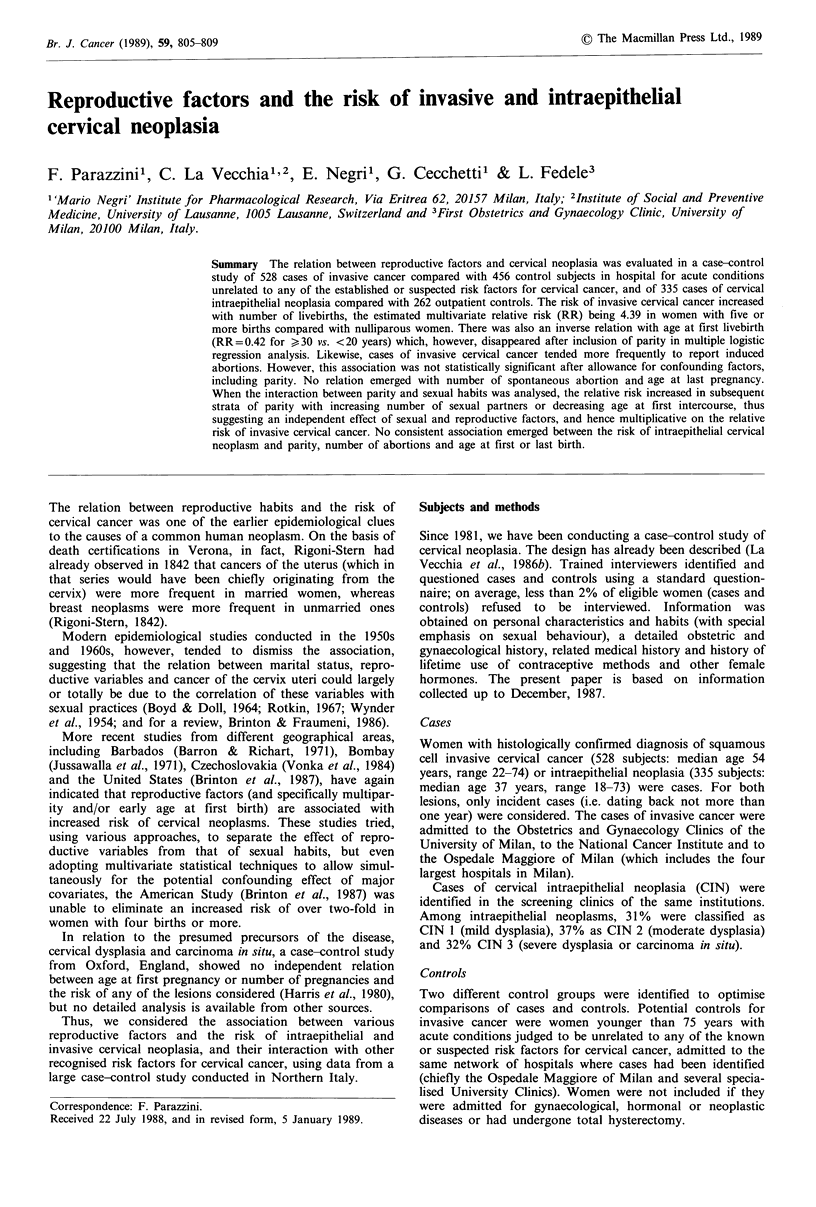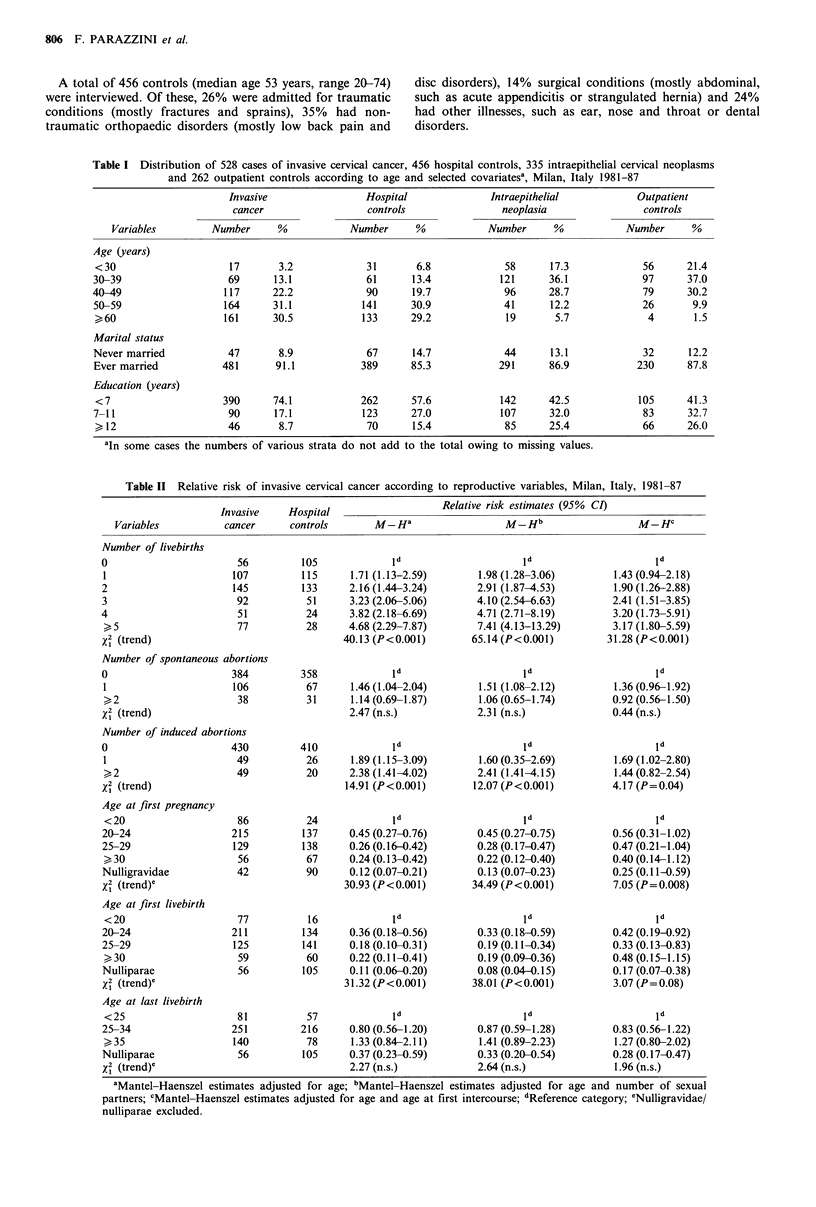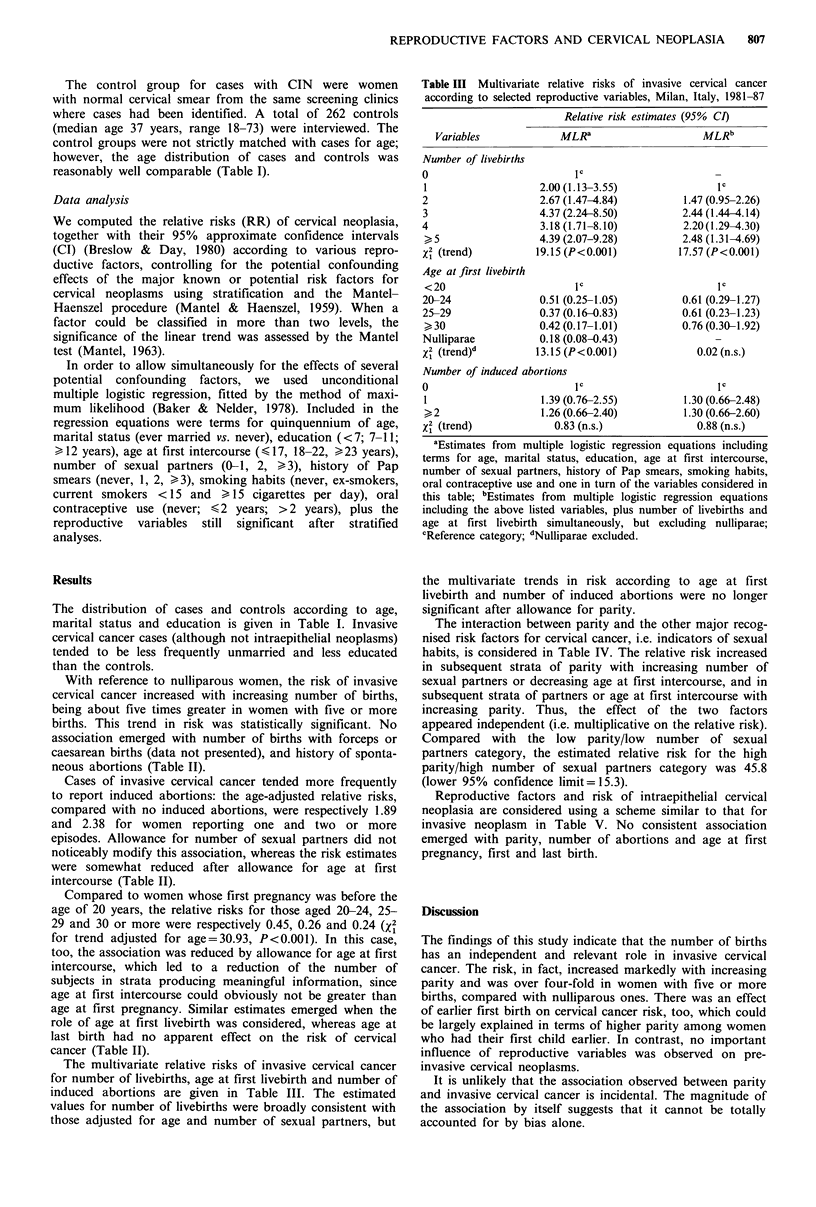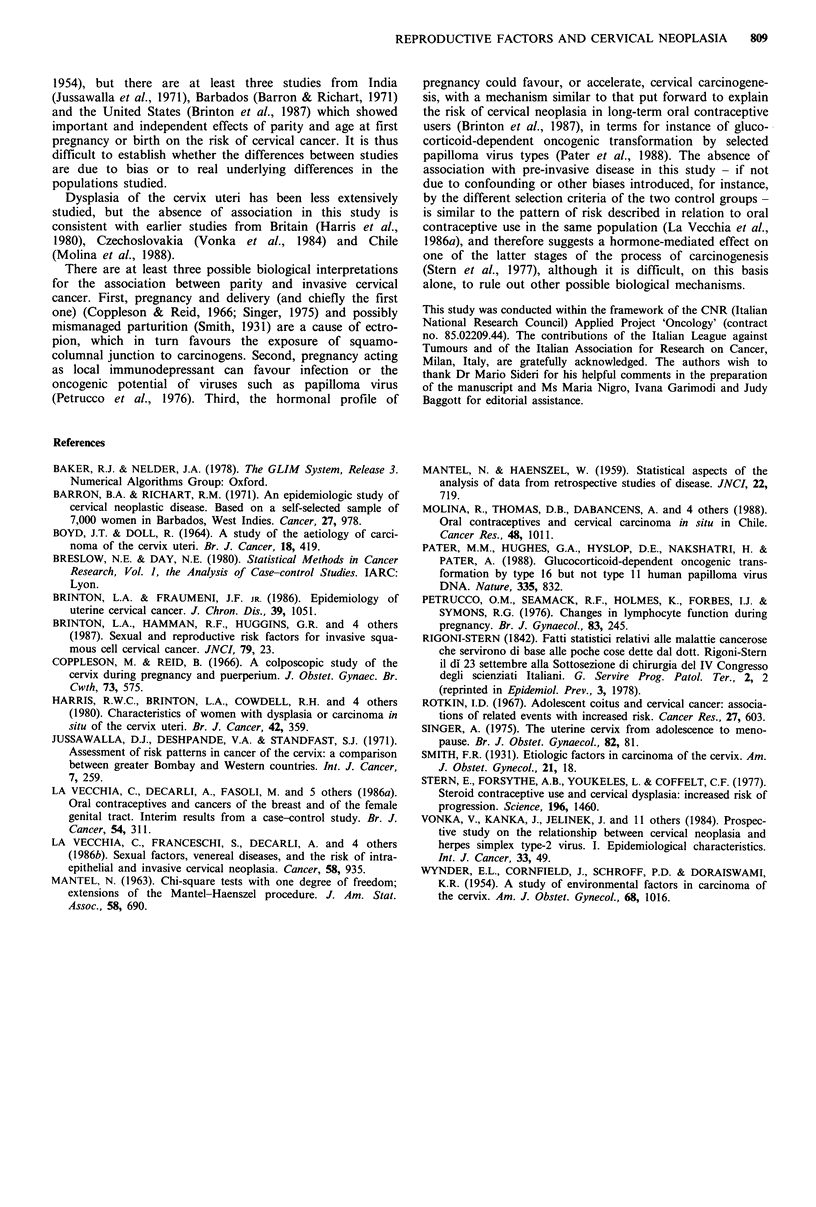Abstract
The relation between reproductive factors and cervical neoplasia was evaluated in a case-control study of 528 cases of invasive cancer compared with 456 control subjects in hospital for acute conditions unrelated to any of the established or suspected risk factors for cervical cancer, and of 335 cases of cervical intraepithelial neoplasia compared with 262 outpatient controls. The risk of invasive cervical cancer increased with number of livebirths, the estimated multivariate relative risk (RR) being 4.39 in women with five or more births compared with nulliparous women. There was also an inverse relation with age at first livebirth (RR = 0.42 for greater than or equal to 30 vs. less than 20 years) which, however, disappeared after inclusion of parity in multiple logistic regression analysis. Likewise, cases of invasive cervical cancer tended more frequently to report induced abortions. However, this association was not statistically significant after allowance for confounding factors, including parity. No relation emerged with number of spontaneous abortion and age at last pregnancy. When the interaction between parity and sexual habits was analysed, the relative risk increased in subsequent strata of parity with increasing number of sexual partners or decreasing age at first intercourse, thus suggesting an independent effect of sexual and reproductive factors, and hence multiplicative on the relative risk of invasive cervical cancer. No consistent association emerged between the risk of intraepithelial cervical neoplasm and parity, number of abortions and age at first or last birth.
Full text
PDF




Selected References
These references are in PubMed. This may not be the complete list of references from this article.
- BOYD J. T., DOLL R. A STUDY OF THE AETIOLOGY OF CARCINOMA OF THE CERVIX UTERI. Br J Cancer. 1964 Sep;13:419–434. doi: 10.1038/bjc.1964.49. [DOI] [PMC free article] [PubMed] [Google Scholar]
- Barron B. A., Richart R. M. An epidemiologic study of cervical neoplastic disease. Based on a self-selected sample of 7,000 women in Barbados, West Indies. Cancer. 1971 Apr;27(4):978–986. doi: 10.1002/1097-0142(197104)27:4<978::aid-cncr2820270433>3.0.co;2-2. [DOI] [PubMed] [Google Scholar]
- Brinton L. A., Fraumeni J. F., Jr Epidemiology of uterine cervical cancer. J Chronic Dis. 1986;39(12):1051–1065. doi: 10.1016/0021-9681(86)90139-6. [DOI] [PubMed] [Google Scholar]
- Coppleson M., Reid B. L. A colposcopic study of the cervix during pregnancy and the puerperium. J Obstet Gynaecol Br Commonw. 1966 Aug;73(4):575–585. doi: 10.1111/j.1471-0528.1966.tb15536.x. [DOI] [PubMed] [Google Scholar]
- Harris R. W., Brinton L. A., Cowdell R. H., Skegg D. C., Smith P. G., Vessey M. P., Doll R. Characteristics of women with dysplasia or carcinoma in situ of the cervix uteri. Br J Cancer. 1980 Sep;42(3):359–369. doi: 10.1038/bjc.1980.246. [DOI] [PMC free article] [PubMed] [Google Scholar]
- Jussawalla D. J., Deshpande V. A., Standfast S. J. Assessment of risk patterns in cancer of the cervix: a comparison between greater Bombay and western countries. Int J Cancer. 1971 Mar 15;7(2):259–268. doi: 10.1002/ijc.2910070210. [DOI] [PubMed] [Google Scholar]
- La Vecchia C., Decarli A., Fasoli M., Franceschi S., Gentile A., Negri E., Parazzini F., Tognoni G. Oral contraceptives and cancers of the breast and of the female genital tract. Interim results from a case-control study. Br J Cancer. 1986 Aug;54(2):311–317. doi: 10.1038/bjc.1986.178. [DOI] [PMC free article] [PubMed] [Google Scholar]
- La Vecchia C., Franceschi S., Decarli A., Fasoli M., Gentile A., Parazzini F., Regallo M. Sexual factors, venereal diseases, and the risk of intraepithelial and invasive cervical neoplasia. Cancer. 1986 Aug 15;58(4):935–941. doi: 10.1002/1097-0142(19860815)58:4<935::aid-cncr2820580422>3.0.co;2-o. [DOI] [PubMed] [Google Scholar]
- MANTEL N., HAENSZEL W. Statistical aspects of the analysis of data from retrospective studies of disease. J Natl Cancer Inst. 1959 Apr;22(4):719–748. [PubMed] [Google Scholar]
- Molina R., Thomas D. B., Dabancens A., Lopez J., Ray R. M., Martinez L., Salas O. Oral contraceptives and cervical carcinoma in situ in Chile. Cancer Res. 1988 Feb 15;48(4):1011–1015. [PubMed] [Google Scholar]
- Pater M. M., Hughes G. A., Hyslop D. E., Nakshatri H., Pater A. Glucocorticoid-dependent oncogenic transformation by type 16 but not type 11 human papilloma virus DNA. Nature. 1988 Oct 27;335(6193):832–835. doi: 10.1038/335832a0. [DOI] [PubMed] [Google Scholar]
- Petrucco O. M., Seamark R. F., Holmes K., Forbes I. J., Symons R. G. Changes in lymphocyte function during pregnancy. Br J Obstet Gynaecol. 1976 Mar;83(3):245–250. doi: 10.1111/j.1471-0528.1976.tb00818.x. [DOI] [PubMed] [Google Scholar]
- Rotkin I. D. Adolescent coitus and cervical cancer: associations of related events with increased risk. Cancer Res. 1967 Apr;27(4):603–617. [PubMed] [Google Scholar]
- Singer A. The uterine cervix from adolescence to the menopause. Br J Obstet Gynaecol. 1975 Feb;82(2):81–99. doi: 10.1111/j.1471-0528.1975.tb02204.x. [DOI] [PubMed] [Google Scholar]
- Stern E., Forsythe A. B., Youkeles L., Coffelt C. F. Steroid contraceptive use and cervical dysplasia: increased risk of progression. Science. 1977 Jun 24;196(4297):1460–1462. doi: 10.1126/science.867043. [DOI] [PubMed] [Google Scholar]
- WYNDER E. L., CORNFIELD J., SCHROFF P. D., DORAISWAMI K. R. A study of environmental factors in carcinoma of the cervix. Am J Obstet Gynecol. 1954 Oct;68(4):1016-47; discussion, 1048-52. doi: 10.1016/s0002-9378(16)38400-9. [DOI] [PubMed] [Google Scholar]


